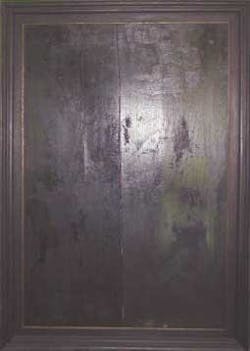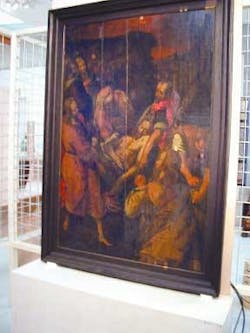Low-fluence UV pulses clean art
Studies have shown that excimer lasers are efficient and safe tools for removing layers of specified thickness from the surface of icons and paintings in a controllable way. To refine the technique, a team from the Institute for Electronic Structure and Laser-Foundation for Research and Technology (IESL-FORTH; Heraklion, Greece) investigated the influence of combining high repetition rates with low laser fluences to optimize the cleaning process. Working close to the ablation threshold, they aimed to minimize any undesirable photochemical or photomechanical effects. Thermal effects due to the high repetition rates were also investigated.
Simulated antiquities
To optimize the laser parameters to clean most effectively, a study was first performed on model samples prepared by the conservation team of the National Gallery of Athens. The samples closely simulate the typical stratigraphy of a Byzantine icon, consisting of a wooden primer foundation followed by a pigment layer, and finally a varnish layer.
The control samples had a homogeneous layer of varnish 20 to 30 µm in thickness and had been aged in an accelerated-aging chamber for 12 weeks. “Dammar” and “mastich of Chios” varnishes (natural varnishes obtained by tapping trees) were chosen for the study because they were commonly used on original Byzantine icons.
The excimer laser used by the group was made by TuiLaser (Munich, Germany) and is air-cooled and compact enough for mobile use. The laser produces approximately 15 mJ/pulse and was chosen for its high beam quality and stability, as well as its ability to operate at a wide range of repetition rates necessary for finely tuning ablation rates. A 248-nm-emitting (krypton fluoride) version of the laser was used for the cleaning experiments.
Following preliminary ablation studies, a fluence of 0.18 J/cm2 (which lies below the cleaning threshold of 0.20‑J/cm2) was chosen to study the effect on the varnishes of a varying number of pulses and repetition rates. The number of pulses was varied from 10 to 200 and the repetition rate was varied from 1 to 200 Hz. The results were then initially evaluated by means of optical microscopy.
It was shown that 50 pulses gave reliable visual evidence of cleaning. Images taken using an optical microscope showed the surface morphology of areas irradiated with 50 pulses at 0.09‑J/cm2 (with 80% overlap in the y axis) at various repetition rates. The IESL-FORTH researchers observed that at high repetition rates (greater than 100 Hz) no satisfactory cleaning was obtained. Instead, extensive bubble formation was seen-presumably due to the inability of the material to dissipate the heat adequately at the higher average powers.
Further testing is needed to more precisely optimize the spot size, energy density, number of pulses, and repetition rate with respect to speed and effectiveness of the cleaning process. But good preliminary results indicate that repeated pulses of low-fluence UV light at moderate repetition rates are extremely efficient at cleaning the control samples.
A panel painting from a small pilgrim chapel (Chapel of the Holy Mary of Genooy) in the south of The Netherlands was completely covered in soot (top). Sjoerd Postma, a laser and applications engineer, and others at Art Innovation (Oldenzaal, The Netherlands), removed the soot with an excimer-laser cleaning setup without damaging the underlying varnish layer, revealing the illustration of the “Entombment of Christ” (center and bottom). The laser cleaning was supervised by the Stichting Restauratie Atelier Limburg (Maastricht, The Netherlands).
Engineers at Art Innovation (Hengelo, The Netherlands), which produces tools for art-restorers, have integrated the same laser into the company’s artifact-restoration device. The tool has been used to clean art without damage (see figure).



